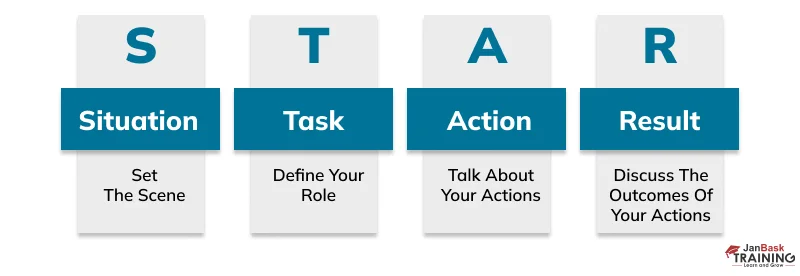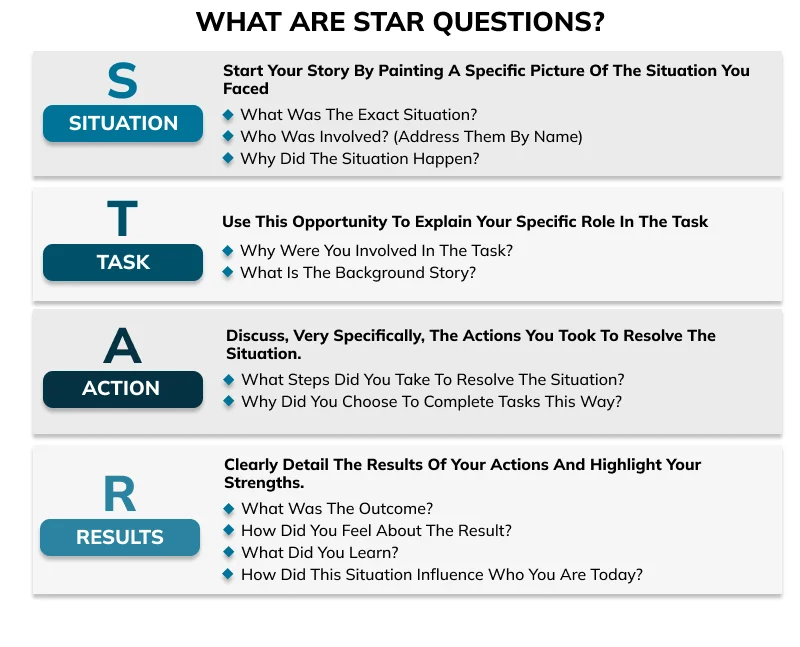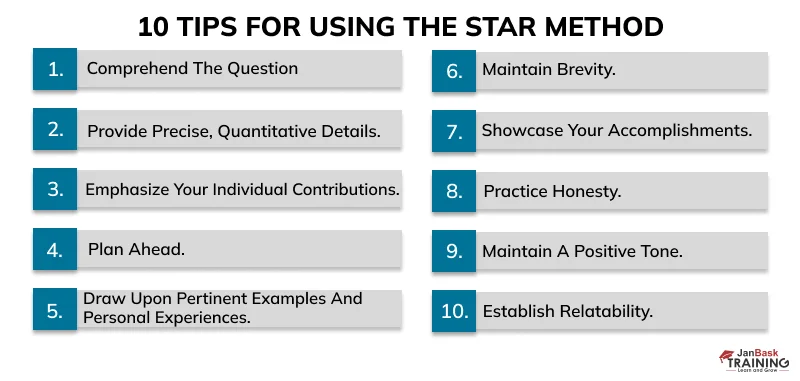Year End Sale : Get Upto 50% OFF on Live Classes + $999 Worth of Study Material FREE! - SCHEDULE CALL
Do you find interviews to be intimidating? If yes, then you are not the only one. But the good news is, you can beat those interview blues with a simple strategy called the STAR method interview. Beyond knowledge lies a constellation of factors contributing to landing a well-paying job. Ever wondered what else can propel you towards interview triumph? The answer: Preparation, along with the STAR Interview Method. Be it a technical round interview for a certified Salesforce professional job or any other, with the proper conditioning of mind, you can ace them like a breeze.
Let’s gear up to discuss how this method can be your north star on the path to professional wins.
Now coming to the STAR Method Interview; it is a guide to a list of strategic viewpoints that help you face the daunting day of the interview with confidence and optimism. The STAR method enables you to elaborate on your professional achievements and experiences in a concise yet impressive manner within the limited time frame allotted to any candidate during his/her interview
Let us break it down into simpler terms so that we can understand the approach easily and precisely.

When it’s about hiring, your knowledge and experience might not be enough. Companies place a significant emphasis on a candidate’s mindset. How and why you act in a particular situation foreshadows how you will perform in leadership roles. Setting the scene is a phase where you learn how to introduce the panel sitting on the other side of the table to your abilities beyond your resume. Additionally, when mentioning scenarios where your past experiences take center stage, describe your context clearly and bring in a backdrop where you demonstrated your capabilities under extraordinary situations.
The second phase prompts you to discuss your past roles and responsibilities comprehensively. It's not about overselling yourself; rather, it's about conveying to the interviewers how you've distinguished yourself and effectively fulfilled the responsibilities assigned to you during plain as well as during stormy waters.
You can get yourself familiar with this vast list of the most commonly asked interview questions carefully curated to soothe the interview process of candidates.
During this step, you'll refine your ability to elaborate on your decision-making in challenging scenarios. Providing a precise and impactful account of a situation where you successfully completed a deliverable on time despite setbacks will leave the impression of being highly dependable.
Whether the outcome is negative or positive, it is always a good practice to share the results of a prolonged struggle or plan. In this phase, you will not only learn to discuss the results but also cultivate an attitude that demonstrates ownership of outcomes and a willingness to learn from mistakes, regardless of future hardships.
Thus, it is safe to say that the STAR method interview practice emphasizes a pretty straightforward format that helps you succeed. When used correctly, candidates can effectively communicate how they can contribute their desired qualities to the company or organization.
The STAR method interview questions and answers are meticulously thought out and devised for behavioral rounds, which are the most difficult to crack. The candidate is subjected to a number of mind games to create an environment of pressure. How you perform in this round gives interviewers insight into how you will perform in real-time high-pressure scenarios.
The STAR method interview practice can be used for those high-stake situations that demand you provide a real-life example of how you handled a complex or tricky situation in the past.
These questions are easy to recognize and typically start with something like this in the following STAR method interview examples of questions:
1. What did you do when...?
This could be about a time when your workflow was not optimum due to lack of information, unfinished reports by other team members, improper work delegation, the pressure of submission amidst multiple modification requests, etc.
2. How did you manage at that time...?
Interviewers can ask you to describe scenarios where you did not have the right resources or conditions to finish a designated piece of work. The COVID-19 pandemic was a challenging period in every professional’s life. Work-from-home setups or remote working setups did not prove to be helpful for many. If you are one of those who have managed to get work done under adverse conditions, this is your chance to shine.
3. Give me an example to back your claim.
Simply listing your achievements isn't sufficient. Recruiters are interested in the how and when of your accomplishments. Additionally, as you share your story, be prepared for interviewers to throw curveballs in the form of questions aimed at testing your integrity and honesty.
4. Have you worked in this kind of scenario?
From tools to processes, recruiters want to know everything that might or might not be listed on your resume. If you've worked on projects that had you burning the midnight oil to expand your skills and contribute to the project in any way, it's worth mentioning. So the more you practice with these STAR method interview examples the better will you become with those interview preparations. Let’s find a few more STAR interview questions and answers in the image below:

More often than not, candidates who have successfully faced critical scenarios in real-time get tongue-tied or fail to describe them properly during interviews and similar assessments. Concise elaboration and articulation are the keys, and the STAR method interview practice equips you with skills that enable you to do exactly that.
With the help of the STAR method interview, any candidate will be able to sense and eventually answer these kinds of questions confidently. But for that, it’s necessary to go through a wide range of STAR interview questions and answers. Recalling instances of past workspaces and describing them with an aura of self-assurance and positiveness will surely leave a lasting impression on recruiters. The STAR interview method examples will teach you how to do so like a pro.
The effectiveness of the method lies within the acronym (S-T-A-R) itself. Any candidate who comprehends the core concept of all four steps is poised to navigate successfully through behavioral and similar rounds. The STAR method interview questions and answers preparation proves to be the ultimate approach to excel in interviews demanding problem-solving abilities, typically essential for consulting and strategic roles.
Before highlighting your role in a certain situation, it is important to discuss the situation in-depth with the interviewer. However, while doing so, it is imperative to ensure that you keep your story interesting, filled with essential highlights, to the point, and conclusive.
Your objective here is to articulate the situation you were in so the interviewer can understand the context clearly. The STAR method advises candidates to keep their answers short, relevant, and simple.
For instance, consider the scenario where the interviewer asks, “Tell me about a time when you achieved a different target than usual.” Your response to the situation can be: “In my previous role as a digital content writer, the company decided to focus on increasing impressions and footfall for the blog section. I ensured to cover topics that were both relevant to the service we were selling and trending at that time. This resulted in more than 10,000 impressions within 2-weeks.”

You are describing the scenario because you had a crucial role in the entire arrangement. This is the part where you can take the liberty to provide more detail or precision about your roles and responsibilities. It's also the moment when you can foreshadow the idea that in a similar future situation, you are likely to demonstrate the same diligence. Interviewers often ask these types of STAR method questions to assess your mindset.
For example, you might say, “In my role as a field sales manager, I was responsible for ensuring that all our salespersons completed their rounds in the designated locations on a bi-weekly basis.”
Now that the recruiter has an understanding of your role, it’s time to elaborate on what you did and how you dealt with challenging situations. Discuss instances that required you to take measures beyond the usual. List out the specific steps you took to achieve your goal or solve the problem. So be prepared for the next STAR method questions and confidently provide detailed examples.
For instance: “When my co-developer had to take three days off just a week before the final code review due to a personal emergency, I put in extra hours, and with assistance from the testing team, I successfully completed the code review on time.”
This is your chance to highlight your contributions or any extra efforts you made to steer the organization or your team through challenging situations. The more you delve into the STAR Interview method examples, the more you’ll know that it suggests keeping a brag sheet where you list anything noteworthy or extra in your professional journey.
Interviewers/Recruiters aren’t looking for superhumans; they are seeking promising professionals willing to own their mistakes and learn from them. More often than not, candidates skip speaking about the result bit, especially if it is not in their favor. What they fail to realize is that the recruiter is not just here to check whether you are skilled or not. The world is full of experts with little to no leadership qualities. They are hunting for individuals who can make informed decisions and perform well in high-stakes situations. Someone who values the process and directs it in a way that guarantees favorable results is the ideal candidate. The STAR method interview and the STAR interview questions and answers always interviewees to be honest and show a flair for constructive criticism for their past goof-ups.
Moreover, interviewers are not only keen to know what you did, but they also want to understand how it helped in the long run and how confident you were about your role and career. Even though numbers are a great and time-saving way to list the positive effects of your actions, some outcomes are intangible and cannot be measured in the usual ways.
For instance, you were the glue of your team. You kept the team together and got things done in times of conflict.
By discerning a list of relevant examples.
Behavioral rounds in global organizations typically include certain common questions. The STAR method questions assist candidates in preparing for what is expected on D-day. Reviewing a list of STAR interview method examples will help you craft your answers well in advance, ensuring you appear and feel confident during the interview.
Example: What according to you is the best way to achieve goals within the desired time-frame?
For this question, the candidate can actually talk about all those times he/she/they consistently managed to complete the project within the deadline.
Here’s how you start:
Situation: “I have been in the ____ industry for __ years. During my tenure, I have realized that setting realistic expectations and conveying them to the higher management from the outset is crucial. The delivery date was set for four months from the date of assignment, and the client still hadn’t provided clear briefs on some aspects of the project.”
Task: “In my role as a ____, the project had unique requirements such as ____, something my team and I hadn’t encountered before. Two months into the project, some team members had to withdraw due to another high-urgency project in the pipeline. This setback increased the workload and extended work hours for the remaining team members.”
Action: “Having faced a similar situation before, I understood that strategic delegation of work was key to restarting with vigor for the second innings. Expectations were clearly communicated, and I ensured each team member took on an extra task, covering the responsibilities of those who had left. This way, the workload was evenly distributed.”
Result: “Despite the need to work two consecutive weekends and take on extra tasks, my remaining team members and I successfully completed the project two days ahead of the submission deadline. Although fatigued, we were extremely proud of our accomplishment. It's worth noting that our seniors were proud and understanding. When half the team had to be reassigned to a different project, they inquired about our ability to complete the task on time. If needed, they were prepared to speak with the client and request an extension. Fortunately, we managed to meet the deadline.”

Before applying the STAR interview method to real-life interview scenarios, you need to have a set of prerequisites.
The STAR interview method, owing to its pragmatic and gradual approach, can significantly enhance the way you perform during job interviews. The method helps you craft responses that are clear, comprehensible, and beautifully structured so that you come across as someone who not only has skills but also the right demeanor to handle high-stakes roles.
The STAR technique is a useful technique that works perfectly, especially when a behavioral question arises in a job interview. Utilizing this structured technique to answer questions will help you demonstrate how you use your abilities, your experiences, your online training, and your qualifications to the companies. It is of utmost importance that these triples of situation, task, action, and result are well practiced and prepared for while you keep honesty and conciseness in your replies. Equipped with the STAR interview approach, you will feel more confident and have higher chances to find the job you’ve always wanted, provided that you have the relevant online IT training and online Certification for the required job you are targeting. Learn to ace the interview and get hired into the place you want with our range of trending courses at JanBask. Acquire the necessary skills, become more confident, and resoundingly pass every interview.
Q1. What is the STAR Interview Method?
Ans. The STAR Interview Method is a strategic approach designed to help candidates excel in job interviews, especially when faced with behavioral questions. It stands for Situation, Task, Action, and Result, guiding candidates to articulate their experiences and achievements effectively within a concise yet impactful framework.
Q2. Does STAR work well for entry-level roles?
Ans. Indeed, the STAR interview technique proves effective for entry-level positions. It aids candidates, irrespective of their level of experience, in organizing their answers and highlighting pertinent skills and attributes.
Q3. How to answer star interview questions?
Ans. To answer STAR interview questions effectively, follow the STAR method:
Situation: Start by describing the context or situation you were in. Provide relevant details to set the scene for the interviewer.
Task: Explain your role and responsibilities within that situation. Be clear about what was expected of you and what tasks you needed to accomplish.
Action: Describe the actions you took to address the situation or complete the task. Focus on your specific contributions, decision-making process, and any challenges you encountered.
Result: Finally, discuss the outcome of your actions. Highlight the impact of your efforts and any positive results achieved. Be honest about any lessons learned or areas for improvement.
Remember to keep your responses concise, relevant, and focused on showcasing your skills and experiences. Practice answering STAR interview questions using specific examples from your past work or personal experiences to effectively demonstrate your abilities to potential employers.
Q4. Is it possible to customize the STAR method?
Ans. Absolutely, you have the flexibility to adjust the STAR method according to your preferences. While maintaining the fundamental structure (Situation, Task, Action, Result), feel free to tailor it to align with the job's particular demands or to emphasize specific facets of your background.
Q5. When Should You Use the STAR Method?
Ans. The STAR Method is ideal for behavioral interview rounds, which often assess how candidates handle real-life scenarios under pressure. Employing this method allows candidates to provide concrete examples of their problem-solving abilities and past experiences, showcasing their suitability for high-pressure roles.
Q6. How Does the STAR Method Work?
Ans. The STAR Method functions by breaking down interview responses into four key components: Situation, Task, Action, and Result. Candidates first describe the context of a past scenario (Situation), outline their role and responsibilities (Task), detail the actions they took to address challenges (Action), and finally, discuss the outcomes of their efforts (Result).
Q7. How do you apply the STAR method for your interview?
Ans. Applying the STAR Method involves understanding the core principles of each step and preparing relevant examples in advance. Candidates should familiarize themselves with common interview questions and craft concise yet compelling responses that align with the STAR framework.
Q8. What are the prerequisites for answering STAR interview questions effectively?
Ans. Before using the STAR Method in interviews, candidates should review the job description thoroughly, have specific examples of past achievements in mind, practice storytelling techniques, and maintain a calm and patient demeanor. These prerequisites ensure candidates are well-prepared to leverage the STAR Method effectively during interviews.
With his detailed research and unique insights into IT and Technological trends, Shubham has been producing high-quality and engaging content that meets the standards of its end-users.

Cyber Security

QA

Salesforce

Business Analyst

MS SQL Server

Data Science

DevOps

Hadoop

Python

Artificial Intelligence

Machine Learning

Tableau
Interviews